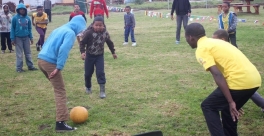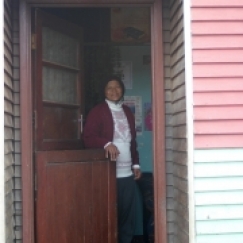
“ My dream has always been to work with children,” said Siphiwe Sikhasa, between playing at the soccer field at the Safe Park in Grabouw, South Africa. Just 45 minutes outside of cosmopolitan Cape Town, the small town with dirt roads looks like a world away.
My dream has always been to work with children,” said Siphiwe Sikhasa, between playing at the soccer field at the Safe Park in Grabouw, South Africa. Just 45 minutes outside of cosmopolitan Cape Town, the small town with dirt roads looks like a world away.
Sikhasa is a coordinator of the Safe Park, a space where children of all ages can safely play, receive homework help, discuss issues burdening young minds, learn valuable skills and oftentimes receive a hot meal. His passion for helping children is apparent as he runs the field and freely gives hugs and high fives. On this particular overcast, drizzling June winter day, there are approximately 20 children playing soccer and 110 children at the Safe Park. Most days there are nearly 200 children.
The Safe Parks are a component of the 309 Isibindi programs established in 161 communities throughout South Africa by the National Association of Child Care Workers (NACCW). Meaning “courage” in IsiZulu, Isibindi is serving more than 200,000 vulnerable children nationwide, including those who are living in grandparent-headed households; child-headed households; have a disability, HIV/AIDS or other disease; are caring for ailing family members; are victims of abuse; face struggles at school or home; or are affected by a number of other factors that could lead to unsafe situations.
In addition to working at the Safe Park, Sikhasa and other trained and supervised Child and Youth Care Workers (CYCWs) continue to help families in their immediate communities by going door-to-door to assess needs and offer support to those who need it. Each worker aids up to 48 children, monitoring a child’s progress, acting as their confidant and providing support in various areas as needed in a child’s life. CYCWs build relationships with children through interaction in typical daily routines- cooking together, reading, household chores and life skills.
 The Nghonyama* family is one of the thousands visited an average of 3-5 times a week by a CYCW. Since 2011, Edwina is the CYCW who has been working with the family’s five children, currently ages 5-17, and the grandmother caring for the children. Three of the children lost both parents to AIDS, one child was abused by his step-father and one was abandoned by her parents. In all cases, Granny Nghonyama stepped in. Some are her biological grandchildren, some she calls her grandchildren. “It doesn’t matter whose child it is, I just have a deep love for children.” Budgeting, homework and overcoming the stigma associated with HIV/AIDS haven’t been easy for this blended family, but have been made easier with the help of Edwina. She has helped to link the family with additional services, including a social worker and government subsidies.
The Nghonyama* family is one of the thousands visited an average of 3-5 times a week by a CYCW. Since 2011, Edwina is the CYCW who has been working with the family’s five children, currently ages 5-17, and the grandmother caring for the children. Three of the children lost both parents to AIDS, one child was abused by his step-father and one was abandoned by her parents. In all cases, Granny Nghonyama stepped in. Some are her biological grandchildren, some she calls her grandchildren. “It doesn’t matter whose child it is, I just have a deep love for children.” Budgeting, homework and overcoming the stigma associated with HIV/AIDS haven’t been easy for this blended family, but have been made easier with the help of Edwina. She has helped to link the family with additional services, including a social worker and government subsidies.
Isibindi is in the second year of a five-year scale up and is being funded by PEPFAR through USAID. With a goal of training 10,000 CYCWs, to date 4,402 CYCWs have been trained.
The Isibindi model has helped formalize child and youth care work as a profession. The program trains unemployed people selected by their communities in a child and youth care accredited training program. Two universities in South Africa now offer a CYCW degree and more than 6,000 workers have been formally registered with the South African Council for Social Service Professions under a new statutory regulation championed by the NACCW.
The Para Professional Interest Group of the Global Social Service Workforce Alliance has drawn from the expertise of NACCW and many others to develop a competency framework for para professionals that includes a section on functions and competencies specific to auxiliary child and youth care workers. The framework is being tested and a first edition will be released later this year. The competencies build upon the Alliance’s global efforts to help plan, develop and support all levels of workers who make up the social service workforce.
In South Africa, the program has been embraced by the government as a best-practice model. Several other countries have recently expressed interest in developing new cadres of CYCWs and are receiving support from NACCW to do so. Ministers from the county government of Kisumu, one of 47 county governments in Kenya, recently visited the Grabouw Safe Park and met families benefiting from the support of CYCWs. “We have engaged the South African network to advise us and help us launch the Safe Park model. I want to…learn how to implement this program,” said Jennipher Atieno Kere, Executive Member for Education, Youth, Culture, Gender and Sports. The Safe Park model is also being replicated within South Africa by more than 20 other organizations and in Zambia.
“While the NACCW developed this program, we’re happy to share it with the world. These child and youth care workers are impacting one life, one family and one community at time, leading to real change here in South Africa, and eventually around the world,” said Zenuella Thumbadoo, Deputy Director, NACCW.
As Sikhasa continues to develop his skills as a CYCW, he prides himself on being a positive male role model to the young lives he influences. “I have younger siblings who have always looked up to me, and I want to continue to be a model for them, and all kids.”
(*names changed to protect the identity of the family)

Comments
Child and Youth Care Work
Passion in Child and Youth Care work very visible, it is something that is alive that cannot be hiden, and this is what Sikhasa is experiencing and sharing. Once you in this Profession, making a difference, as I persive it to be, you commit yourself in doing more alongside children and young people in the Safe park. Thank you to the Grabouw Child and Youth Care Team. More over I wish to thank the the ZACCW organization of Child and Youth Care Workers in Zambia for having taken up the challenge of creating a vibrant concept of the Safe Park in Zambia. I was There!!!. It was not for nothing but for the goodwill of our children in our communities.
Isibindi model is indeed a
Isibindi model is indeed a model worth adopting because it handles the vulnerable child or youth from the family and community levels giving the individual a new look at life especially with the input from trained workforce. It is just the right time for kenya to adopt the model to help us take care of the number of orphan vunlerabe children which is on the raise
Isibindi model is indeed a
Isibindi model is indeed a model worth adopting because it handles the vulnerable child or youth from the family and community levels giving the individual a new look at life especially with the input from trained workforce. It is just the right time for kenya to adopt the model to help us take care of the number of orphan vunlerabe children which is on the raise